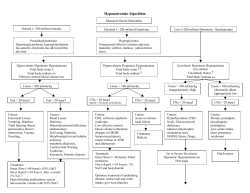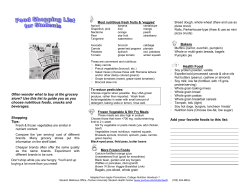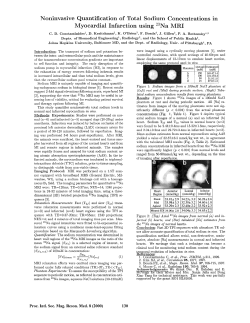
ELECTROLYTE IMBALANCE Dr Ruwan Parakramawansha MBBS, MD, MRCP(UK),MRCPE, DMT(UK) (2013/01/24)
ELECTROLYTE IMBALANCE Dr Ruwan Parakramawansha MBBS, MD, MRCP(UK),MRCPE, DMT(UK) (2013/01/24) OUT OUTLINE…. Pathophysiology, Clinical Features, Aetiology and Management of..... A. Hyponatraemia B. Hyperkalaemia HYPONATRAEMIA The most common electrolyte disorder(occur in up to 6% of hospitalized patients) Serum sodium concentration of <135 mEq/L Due to an excess of body water relative to body sodium content Changes in total body water is regulated by thirst, arginine vasopressin(AVP) and the kidney HYPONATRAEMIA Three types: 1. Hypovolaemic Hyponatraemia 2. Hypervolaemic Hyponatraemia 3. Euvolaemic Hyponatraemia HYPONATRAEMIA HYPONATRAEMIA HYPONATRAEMIA CARDIAC FAILURE CIRRHOSIS CLINICAL FEATURES CNS symptoms – Sodium <125 mEq/L – – – – – Disorientation Restlessness and agitation Apathy Psychosis Seizures Others – nausea,vomiting, headache, muscle cramps COMPLICATIONS OF SEVERE HYPONATRAEMIA Due to hyponatraemia induced cerebral oedema, I. II. III. IV. Respiratory arrest Coma Brainstem herniation Death TREATMENT Rapid correction of hyponatraemia can cause OSMOTIC DEMYELINATION Goal - to raise the serum sodium level by 1.5 to 2 mEq/L/hour ( <= 12 mEq/L for 24 hours) OSMOTIC DEMYELINATION Characterized by confusion, quadriplegia, pseudobulbar palsy, and ‘locked-in syndrome’ TREATMENT OPTIONS Hypertonic saline (3%) Loop diuretics e.g. Frusemide For hypervolemic and euvolemic hyponatremia: – – – Fluid restriction Demeclocycline AVP antagonists e.g. Conivaptan TREATMENT OPTIONS Demeclocycline: Inhibits AVP action at the distal renal tubules Render AVP ineffective even in the presence of increased AVP levels Loss of free water in urine TREATMENT OPTIONS Arginine vasopressin receptor antagonists : Act as an antagonist of vasopressin receptors Block the effect of vasopressin Excretion of free water in urine POTASSIUM BALANCE The ratio of ICF:ECF K+ concentration ∼38:1 Maintained by basolateral Na+, K+-ATPase pump To maintain the steady state, K+ ingestion should be matched with excretion K+ secretion at distal convoluted tubule and cortical ducts – main contributor to K+ excretion HYPERKALAEMIA Plasma K+ concentration >5.0 mmol/L Chronic hyperkalemia - always due to decreased renal K+ excretion Hyperkalemia partially depolarizes the cell membrane and prolonged depolarization impairs membrane excitability CLINICAL FEATURES Impaired cell membrane excitability causes, Nervous system : Weakness and flaccid paralysis – Heart : ECG changes → ventricular fibrillation/asystole – HYPERKALAEMIA-- CAUSES HYPERKALAEMIA Renal failure Decreased K+ secretion – Adrenal insufficiency, drugs (ACE inhibitors, NSAIDs, heparin) Resistance to aldosterone: – tubulointerstitial disease, drugs (K+-sparing diuretics,) TREATMENT 1. Discontinuing exogenous K+ intake and drugs reducing K+ excretion e.g. Angiotensin Converting Enzyme Inhibitors 2. Minimizing membrane depolarization and excitability – Calcium gluconate TREATMENT 3. Shifting K+ into cells – – – 4. Insulin (with glucose to prevent hypoglycemia) NaHCO3 β2-adrenergic agonists e.g. Salbutamol Promoting K+ loss – – – Diuretics Cation-exchange resin e.g. Sodium polystyrene sulfonate Dialysis SUMMARY SUMMAR Y Pathophysiology, Clinical Features, Aetiology and Management of..... A. Hyponatraemia B. Hyperkalaemia
© Copyright 2025











